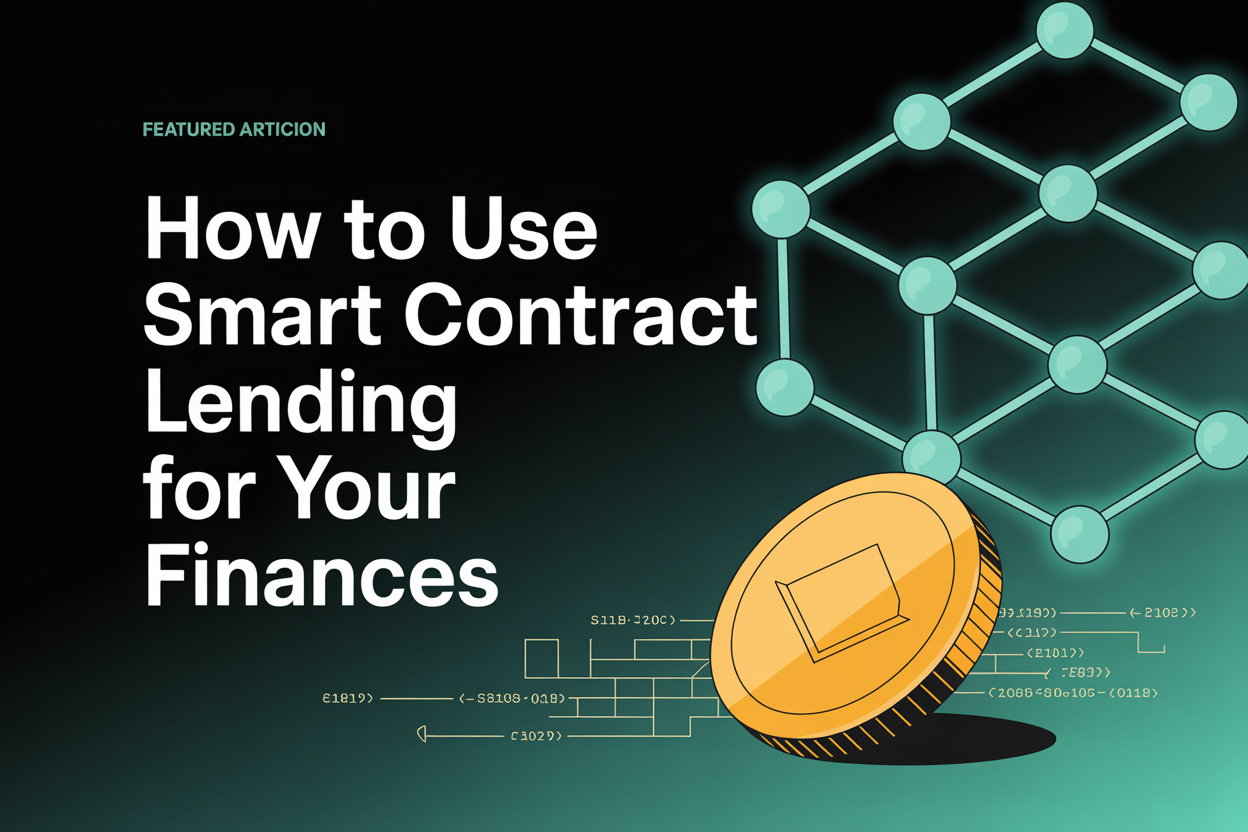Now Reading: How to Use Smart Contract Lending for Your Finances
- 01
How to Use Smart Contract Lending for Your Finances
How to Use Smart Contract Lending for Your Finances

Decentralized finance has changed how we handle money, and smart contract lending leads this change. It uses blockchain to make lending and borrowing safe, clear, and fast.

This approach cuts out middlemen, saving money and speeding up deals. So, people can handle their money better with smart contract lending.
Key Takeaways
- Understand the basics of smart contract lending and its role in decentralized finance.
- Learn how smart contract lending can enhance financial management.
- Discover the benefits of using blockchain technology in lending.
- Explore how smart contract lending reduces the need for intermediaries.
- Find out how to leverage smart contract lending for better financial outcomes.
Understanding Smart Contract Lending
Smart contract lending is changing the financial world with blockchain technology. It’s making borrowing and lending easier and clearer.
What Are Smart Contracts in Finance?
Smart contracts are like self-running contracts. They have the agreement written in code. They live on a blockchain, making them safe and open. In finance, they help with decentralized finance lending. They make lending automatic, cut out middlemen, and lower default risks.
How Blockchain Technology Powers Lending
Blockchain technology is key to smart contract lending. It creates a safe, shared record of deals. This lets people trust each other without needing to, making sure deals are done right.
Automation and Trustless Transactions
Smart contracts make lending smooth and precise. They cut out the middlemen, saving money and speeding things up.
Immutable Record-Keeping
The blockchain technology keeps all deals safe and unchanged. This makes lending more trustworthy and secure.
The Evolution of Decentralized Finance Lending
The DeFi lending world has changed a lot since it started. It moved from old banking systems to decentralized finance (DeFi). Now, cryptocurrency lending platforms are key players.
From Traditional Banking to DeFi
Traditional banking has always been important in finance. But DeFi came along and changed things. It offers lending without middlemen. This has made finance more accessible to everyone.
Key Milestones in Smart Contract Lending Development
There have been a few big moments in smart contract lending:
- The introduction of blockchain technology
- Ethereum’s role in DeFi lending
- Cross-chain lending innovations
Ethereum’s Role in DeFi Lending
Ethereum has been a big help in DeFi lending. It has a strong platform for smart contracts. This supports many lending protocols.
Cross-Chain Lending Innovations
Cross-chain lending has made DeFi lending even better. It lets different blockchain networks work together. This makes cryptocurrency lending platforms more flexible and far-reaching.
Benefits of Smart Contract Lending Over Traditional Options
Smart contract lending is more open, safe, and fair than old ways of lending. This is thanks to automated lending protocols that make lending easier.
Accessibility and Financial Inclusion
Smart contract lending makes money services available to more people. Anyone with the internet can join in, no matter where they are or their money situation.
Reduced Intermediary Costs
Smart contracts cut down on the need for middlemen. This means lower costs for lenders and borrowers, making things more efficient.
Transparency and Immutability
Transactions on these platforms are recorded on a blockchain. This makes everything clear and unchangeable, building trust and security.
Programmable Money Features
Smart contracts let you create special lending deals. This flexibility helps offer many financial products, meeting different needs.
Smart contract lending is changing the financial world. It’s making lending more open, affordable, and secure than old methods.
Potential Risks and Challenges
Smart contract lending is innovative but comes with risks. As digital asset borrowing grows, knowing these risks is key.
Smart Contract Vulnerabilities
Smart contract lending faces a big risk: code vulnerabilities. These can be used by hackers to steal money. It’s vital to check the risks of smart contract lending and pick secure platforms.
Regulatory Uncertainties in the US
The US rules for smart contract lending are still changing. It’s important to keep up with these changes. Unclear rules can make lending practices risky or even illegal.

Market Volatility Considerations
Market changes can also be a big risk. Price swings can change the value of collateral. Users need to be ready for these changes when borrowing digital assets.
Impermanent Loss Risks
Impermanent loss is another risk, especially for liquidity providers. It happens when asset values change, leading to losses. Knowing these risks helps avoid big problems.
Essential Tools for Smart Contract Lending
To get into smart contract lending, you need the right tools. You’ll need a full set of tools for secure lending solutions.
Digital Wallets and Key Management
A digital wallet is key for handling cryptocurrencies. It’s important to manage your keys well to keep your assets safe. Think about using hardware wallets like Ledger or Trezor for better security.
Blockchain Explorers and Analytics
Blockchain explorers help you see transactions and smart contract actions. Tools like Etherscan or BscScan give you important info on blockchain activity.
Price Oracles and Monitoring Tools
Price oracles give smart contracts real-time market data. This helps set up good lending rates and when to liquidate. Monitoring tools track how the market and protocols are doing.
- Use Chainlink for reliable price feeds.
- Utilize monitoring tools like DeFi Pulse for protocol insights.
Setting Up Your Digital Wallet for Lending
A digital wallet is key to joining smart contract lending platforms. You need a secure wallet that works with different blockchain networks to start lending.
Choosing the Right Wallet
Picking the right digital wallet is important for lending. Look at several factors to make sure your wallet fits your needs.
Hardware vs. Software Options
Digital wallets are either hardware or software. Hardware wallets, like Ledger or Trezor, keep your private keys safe offline. Software wallets, like MetaMask, are easy to use but less secure. Choose based on your security needs and preferences.
- Hardware Wallets: Offline storage, high security
- Software Wallets: Convenient, user-friendly interface
Multi-Chain Compatibility
Make sure your wallet works with many blockchain networks. This lets you use different lending protocols on various chains, like Ethereum or Binance Smart Chain.
Securing Your Private Keys
Your private keys are very important. Losing them can mean losing your assets. Always keep them safe and never share them.
Funding Your Wallet
After setting up your wallet, fund it with the cryptocurrency you want to lend. You can move assets from another wallet or exchange. For more on creating a crypto wallet, check this resource.
When adding funds, remember the transaction fees and how long it takes for confirmation on the blockchain.
Top Cryptocurrency Lending Platforms to Consider
Cryptocurrency lending is becoming more popular. It’s important to look at the top platforms in the market. This field has changed how we deal with digital assets, offering new ways to lend and borrow.
Centralized Lending Options
Centralized lending platforms offer a traditional way to lend cryptocurrencies. They have easy-to-use interfaces and customer support. Some well-known platforms are:
BlockFi, Celsius, and Nexo
- BlockFi: It’s known for its interest-bearing accounts and letting you borrow against your crypto.
- Celsius: It offers good interest rates and a mobile app for easy management.
- Nexo: It provides instant loans and a crypto-backed credit card.
Decentralized Protocol Comparison
Decentralized lending protocols use blockchain technology. They allow for secure transactions without middlemen. Key protocols are:
Aave, Compound, and MakerDAO
- Aave: It offers many assets for lending and borrowing, including flash loans.
- Compound: It lets users earn interest or borrow against collateral, with an algorithmic interest rate.
- MakerDAO: It’s known for its stablecoin DAI, made by locking collateral in smart contracts.
Security Track Records
When picking a lending platform, check their security and past performance. Look for platforms with strong security audits and a clear history of automated loan agreements and collateral management.
In conclusion, both centralized and decentralized platforms have their benefits. Understanding their features and security measures helps users make smart choices for their cryptocurrency lending.
Step-by-Step Guide to Your First Smart Contract Loan
The world of decentralized finance lending is opening up new opportunities for borrowers. Smart contract technology has made getting a loan easier and more accessible. Here, we’ll guide you through the steps to get your first smart contract loan.
Selecting the Right Platform
Choosing the right platform is key for a good smart contract lending experience. Look for platforms that are clear, secure, and easy to use. Popular platforms often have a good track record and community support.
Understanding Terms and Conditions
Before you start, it’s important to know the loan terms. This includes interest rates, collateral needs, and how you’ll repay. Carefully review the smart contract terms to avoid surprises.
Executing Your First Transaction
After picking a platform and understanding the terms, it’s time to make your first transaction. Here are the steps:
- Approving Token Spending: Let the platform use your tokens.
- Depositing Collateral: Put up the collateral needed for your loan.
- Borrowing Assets: Get the loan amount in digital assets.
Approving Token Spending
To start, you’ll need to approve token spending. This lets the smart contract use your tokens for collateral. It’s a big step that needs careful thought.
Depositing Collateral
After approving token spending, deposit your collateral. Make sure you know the collateralization ratio to avoid losing your assets.

With your collateral in place, you can borrow the assets you need. Keep an eye on interest rates and repayment terms to manage your loan well.
Monitoring Your Position
After getting your first smart contract loan, it’s important to keep an eye on it. Watch your collateralization ratio, interest rates, and market changes. This helps you manage your loan effectively.
How to Evaluate Automated Lending Protocols
Cryptocurrency lending platforms are growing fast. It’s key to check if they are safe and work well. Knowing what makes a protocol reliable is important.
Assessing Protocol Security
Security is top when looking at automated lending protocols. Check the audit history and if it’s been checked by trusted firms.
Audit History and Bug Bounties
Protocols with clear audit histories and bug bounty programs show they care about security. This means they’re always looking to fix problems.
Understanding Interest Rate Mechanisms
How interest rates work can affect how much you make. Some protocols use fixed or variable interest rates. Knowing how these rates are set is important.
Community and Development Activity
A protocol’s community engagement and development activity show its health. Active development and a strong community mean a protocol is likely to be secure and adaptable.
Total Value Locked (TVL) Analysis
TVL shows the total value of assets in a protocol. A higher TVL means a more stable and established protocol.
Strategies for Digital Asset Borrowing
Borrowing digital assets has become easier with automated lending protocols. This change has opened up new financial chances for investors and those wanting to use their crypto.
Leveraging Existing Crypto Holdings
One key strategy is using your crypto as collateral for a loan. This way, you can get a loan without selling your assets. It lets you keep your investments while getting the cash you need.
Managing Collateralization Ratios
It’s important to manage your collateralization ratios well. A higher ratio can protect you from market ups and downs. This reduces the risk of losing your assets.
Avoiding Liquidation Events
To dodge liquidation, keep a close eye on your collateral ratio. Make sure you have a good margin above the minimum. This helps safeguard your assets.
Health Factor Monitoring
It’s also key to watch your loan’s health factor. This factor shows the risk level of your loan. A higher factor means less risk of losing your assets.
Tax Implications of Crypto Loans
Knowing the tax rules for crypto loans is crucial. In many places, borrowing against your crypto might not be taxable. But, always check with a tax expert to follow local laws.
By using these strategies, borrowers can handle their digital asset loans well. This helps them use their finances more flexibly.
Maximizing Returns as a Lender
To make the most money as a DeFi lender, you need a smart plan and careful risk handling. You must know how to use the tools and methods at your disposal.
Yield Farming Strategies
Yield farming is a top way to boost earnings in DeFi lending. It’s about using different systems to get the best returns.
Single-Asset vs. Liquidity Pool Lending
There are two main ways to lend: single-asset lending and liquidity pool lending. Single-asset lending means lending just one asset. Liquidity pool lending means lending to a mix of assets, with different risks.
- Single-asset lending is simpler and might be safer.
- Liquidity pool lending can give better returns but also has more risks, like losing money temporarily.
Risk Management Techniques
Managing risk well is key for lenders to keep their money safe. This includes spreading investments across various protocols and keeping an eye on market trends.
Portfolio Diversification Across Protocols
Spreading your lending across many protocols can lower risk. By investing in different places, you avoid losing everything if one fails.
Compounding Interest Strategies
Compounding interest can really grow your money over time. By putting interest back into your investment, you can see your wealth grow fast.
- Make reinvesting automatic to get the most from compounding.
- Keep an eye on interest rates to find the best places to invest.
Using these tactics, lenders can earn more in DeFi lending while keeping their investments safe.
Secure Lending Solutions: Protecting Your Assets
When you start with smart contract lending, keeping your assets safe is key. With more people using automated loan agreements, lenders need strong security. This is to protect their investments.

Multi-Factor Authentication Implementation
One important step is to use multi-factor authentication (MFA). MFA adds a layer of security to your digital wallets and lending sites. It makes it harder for others to get into your accounts.
- Use authenticator apps or hardware tokens for added security
- Enable biometric authentication when available
- Regularly update and patch your authentication methods
Insurance Options for Crypto Lending
Looking into insurance for your lending is also crucial. Platforms like Nexus Mutual offer protection against DeFi risks, including smart contract failures.
Nexus Mutual and Other DeFi Coverage
Nexus Mutual has a decentralized insurance platform. It lets users buy coverage for their smart contract lending. Other services, like Unslashed Finance, offer similar protection.
Regular Security Audits and Updates
To keep your lending safe, regular security checks and updates are a must. This includes:
- Monitoring platform security advisories
- Updating your smart contract code to address known vulnerabilities
- Participating in community discussions about security best practices
By taking these steps, lenders can greatly improve the security of their smart contract lending. This helps protect their assets.
Understanding Peer-to-Peer Lending Contracts
The rise of decentralized finance lending has brought about peer-to-peer lending contracts. These contracts allow people to lend and borrow assets directly. They do this without the need for middlemen.
Direct Lending vs. Pool-Based Systems
Peer-to-peer lending contracts come in two types: direct lending and pool-based systems. Direct lending means a direct deal between the lender and borrower. Pool-based systems, on the other hand, have many lenders contributing to a pool. Borrowers then take from this pool.
Evaluating Borrower Creditworthiness
It’s key to check if borrowers can pay back in peer-to-peer lending. This is done through credit scores and collateral.
Dispute Resolution Mechanisms
Good ways to solve disputes are crucial in peer-to-peer lending. Options include arbitration and mediation. These ensure disputes are handled fairly and quickly.
Cross-Border P2P Lending Opportunities
Blockchain lending opens up global lending opportunities. It helps with financial inclusion worldwide. But, it also brings up regulatory issues that need to be sorted out.
In summary, peer-to-peer lending contracts are a new way to lend and borrow. They use decentralized finance and blockchain technology. Knowing about these contracts and their workings helps people make smart financial choices.
Automated Loan Agreements: Reading the Fine Print
Automated loan agreements are changing the way we borrow and lend money. It’s important to understand them well to make smart financial choices. Let’s explore the details of cryptocurrency lending platforms and automated lending protocols.
Liquidation Procedures and Thresholds
Liquidation procedures are key in automated loan agreements. They tell us when and how a loan is sold off, usually when the collateral’s value drops too low. Knowing these points is crucial to avoid sudden sales. For more info, check the Smart Contracts Report.
Fee Structures and Hidden Costs
Automated lending protocols have fees like origination fees and interest rates. Sometimes, there are hidden costs too. It’s important to understand these fees to know the real cost of borrowing or lending. Clear fee structures help us make better choices.
Protocol Governance Rights
Governance rights in automated lending protocols let users shape decisions. These rights differ among protocols. Knowing your rights is key to influencing the protocol’s direction.
Emergency Shutdown Procedures
Emergency shutdowns are for when something goes wrong or a security breach happens. They protect the protocol and its users. Knowing how these procedures work can give you peace of mind and help you act fast in emergencies.
By carefully reading the fine print of automated loan agreements, we can better understand cryptocurrency lending. Whether you lend or borrow, knowing these agreements is essential to fully use automated lending protocols.
Integrating Smart Contract Lending into Your Financial Plan
Smart contract lending opens new doors for financial growth. It’s a fresh way to diversify your investments. As the financial world changes, adding this method can boost your strategy.
Balancing Traditional and DeFi Investments
Finding the right mix of traditional and DeFi investments is key. This balance helps manage risks and increase earnings. Secure lending solutions are vital for protecting your money.
Creating a Sustainable Lending Strategy
Building a lasting lending plan is crucial. It involves setting both short-term and long-term goals. Short-term goals might focus on quick cash, while long-term goals aim for steady income.
Short-term vs. Long-term Goals
It’s important to know the difference between short-term and long-term goals. Short-term needs might require liquid assets. Long-term goals can grow with time.
Regular Portfolio Rebalancing
Keeping your investment mix right is essential. Regularly check and adjust your portfolio to match your goals.
Record-Keeping for Tax Compliance
Keeping accurate records is key for tax purposes with smart contract lending. Detailed records make tax time easier and help you use all available deductions.
In summary, smart contract lending in your financial plan needs careful thought. It involves balancing investments, planning for the future, and keeping records. With secure lending solutions and knowledge, you can handle the ups and downs of smart contract lending.
The Future of Smart Contract Lending and What It Means for You
Smart contract lending is changing fast, with peer-to-peer lending and automated agreements leading the way. Blockchain tech is getting better, making decentralized finance (DeFi) lending more popular.
This change means more clear, safe, and easy-to-use lending options. Automated agreements let people lend and borrow without needing middlemen. This cuts down costs and makes transactions more direct.
As DeFi lending grows, it’s key to keep up with new trends and smart ways to lend. Knowing the ups and downs of smart contract lending helps people plan their finances better.
The future of smart contract lending looks bright, with many new uses on the horizon. As tech advances, more people will get to use financial services in new ways. This could make getting loans and credit easier for everyone.
FAQ
What is smart contract lending, and how does it work?
Smart contract lending uses blockchain to make lending and borrowing easier. It removes the need for middlemen. This way, transactions are secure and trustworthy.
What are the benefits of using smart contract lending platforms?
These platforms make lending more accessible and cut down on costs. They are transparent and secure. Plus, they allow for complex financial deals.
How do I choose the right digital wallet for smart contract lending?
Look for security, compatibility, and ease of use in a digital wallet. Hardware wallets like Ledger are very secure. Software wallets like MetaMask are easy to use.
What are the risks associated with smart contract lending, and how can I mitigate them?
Risks include vulnerabilities in smart contracts and market volatility. To reduce these risks, do your homework, diversify, and keep up with market news.
How do I evaluate the security of an automated lending protocol?
Check the protocol’s audit history and bug bounties. Look for a strong audit record and a clear bug bounty program.
What is the difference between centralized and decentralized lending platforms?
Centralized platforms, like BlockFi, are traditional. Decentralized platforms, like Aave, use blockchain for more control and transparency.
How do I manage collateralization ratios when borrowing digital assets?
Keep an eye on your loan-to-value ratio. Adjust your collateral to avoid losing assets and keep a healthy ratio.
What are the tax implications of crypto loans, and how can I ensure compliance?
Tax rules for crypto loans vary by location and loan terms. Always consult a tax expert and keep detailed records of your loans.
How can I maximize returns as a lender in the DeFi lending space?
Use strategies like yield farming and diversify your portfolio. Stay updated on market trends to adjust your strategy.
What are the key considerations when integrating smart contract lending into my financial plan?
Balance DeFi with traditional investments. Create a solid lending plan and keep accurate records for taxes.















